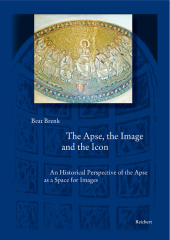 Neuerscheinungen 2010Stand: 2020-01-07 |
Schnellsuche
ISBN/Stichwort/Autor
|
Herderstraße 10
10625 Berlin
Tel.: 030 315 714 16
Fax 030 315 714 14
info@buchspektrum.de |

Beat Brenk
The Apse, the Image and the Icon
An Historical Perspective of the Apse as a Space for Images
2010. 220 p. 106 SW-Abb., 37 Farbabb. 24 cm
Verlag/Jahr: REICHERT 2010
ISBN: 3-89500-703-X (389500703X)
Neue ISBN: 978-3-89500-703-3 (9783895007033)
Preis und Lieferzeit: Bitte klicken
This book deals with the apse as a showcase for images in the early Christian and early Byzantine periods. Two opposed traditions, harking back to early imperial times, nourished the invention of the Christian apse image: on the one hand there were statues in apses of pagan temples and imperial cult rooms which were venerated during cult ceremonies, on the other hand, there were apse mosaics in nymphaea where aquatic myths and figures celebrated the amenities of water. Christian apse mosaics originated within this context and in spite of the Old Testament prohibition of the image. Mosaics and frescoes in apses of cult rooms generated very particular effects, evoking in the viewer respect, admiration, awe and maybe even veneration. The capacity of the image to have an impact on the viewer could not be decreed by the Church, but this was an affair manifested more or less casually according to the inventive power of the artist. This book explores the interactions between the various image-media during the early Christian and early Byzantine periods; it particularly investigates the participation of the viewer and of the patron.
"Benk´s short study is not entirely satisfying. In the repititions from chapter to chapter, and in the numerous asides and observations, one may still hear the presentations of lectures that do not translate well or immediately to thr published page. More vigorous editing might be also have helped clean up some problematic aspects of the text (32,72,91n334), as well as numerous mystifying passages in this volume; (...) Yet the grounds for the correlation of the deictic and of visual worship, as well as the precise understanding and historical force of these terms, remain elusive. While provocative, this remains an unfinished project."
Charles Barber
In: .Studies in Inconography 34 (2013) S.252-254.
--------------------------------------
"Trotz seines anspruchsvollen und detailreichen Inhalts ist der Text gut zu lesen, da für die behandelten Bildwerke in der Regel eine farbige oder schwarz-weiße Abbildung vorliegt. Eine Zusammenfassung, ein Literaturverzeichnis und ein kurzer Index sind beigegeben. Dem Buch ist eine weite Verbreitung zu wünschen, da es nicht nur Kenntnisse vermittelt, sondern durch offenbleibende Fragen auch die Forschung anregen kann."
Josef Engemann
In: Jahrbuch für Antike und Christentum. 53 (2010). S. 216-220.
------------------------------------
"In ancient architecture, the apse was a privileged place for setting up statues of emperors or deities. In the case of public wells (nymphaea), the apse was frequently decorated with mythological scenes relating to water. Against this backgraound Brenk develops his historical account of how the apse became a place for Christian mosaics, especially for the Vrigin Mary. Brenk also explains that in early-Christian worship, images did not play any role at all, while in private, some Christians did use Christian images. Among the churches discussed, S. Maria Maggiore in Rome and S. Apollinare Nuovo in Ravenna figure prominently, though the author also looks at churches in Egypt and Coptic art. - An important contribution to the study of early-Christian art."
In: International Review of Biblical Studies. 56 (2009) 10. No 2057.
------------------------------------
"Kniha je uzitecnìm vstupem do problematiky rane krestanské ikonografie (...)."
[Das Buch ist ein nützlicher Beitrag in die Probleme der frühchristlichen Ikonographie (...).]
PhDr. Peter Kovác
In: Stavitelé Katedrál
April 2011)


